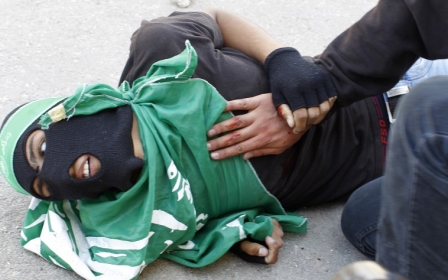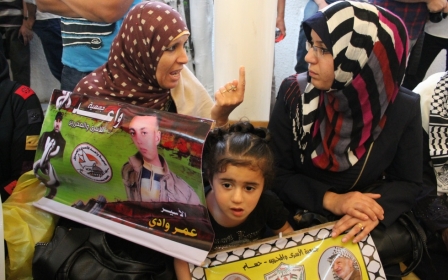PLO accuses Israel of 'deliberate execution' of teenagers

A senior Palestinian official accused Israel of deliberating executing two Palestinian teenagers last week while they participated in a Nakba Day protest in the West Bank town of Beitunia.
The Palestine Liberation Organisation's Hanan Ashrawi said on Wednesday that the organisation condemns the "deliberate execution" of the two unarmed young people "in the strongest possible terms."
"Israel's use of excessive and indiscriminate violence and live ammunition at non-violent Palestinian demonstrations constitutes war crimes and crimes against humanity under international law," she said.
Ashrawi's comments follow the release of video footage by two human rights organisations that appears to show that two teenagers shot and killed by Israeli border troops last Thursday were far from the clashes that broke out following a demonstration in which they participated.
Nadeem Siam Nawara, 17, and Mohammad Mahmoud Odeh, 16, reportedly died in or enroute to a Ramallah hospital after they were both shot in the chest during the protest near Ofer military prison.
A 15-year-old, Mohammad Abdullah Hussein al-Azzeh, was shot in the back and left lung, and is currently in a stable condition at the Ramallah Medical Complex, according to Defence for Children International-Palestine, one of the organisations which released video footage of the incident.
DCI's footage, shot from one fixed location, shows one of the teenagers walking slowly towards a building where around 10 other young people are standing.
At 1:45 pm, according to a timer on the footage, he appears to be shot in the back, and falls onto outstretched arms and then to the ground.
Seconds later, young people run towards him and start to carry him away from the scene.
More than an hour later, at 2:58pm, the same area fills with smoke from fires that appear to be around 30 feet (9 metres0 from where the young people had been standing.
The second teenager is then allegedly shot as he walks towards the smoke, subsequently falling to his knees.
After DCI's release of the footage, Israeli human rights NGO B'Tselem put out several more videos which show the incident from two different angles.
The acts "amount to war crimes," said DCI-Palestine's executive director Rifat Kassis, urging the Israeli authorities to conduct "serious, impartial and thorough investigations to hold the perpetrators accountable for their crimes."
"The images captured on video show unlawful killings where neither child presented a direct and immediate threat to life at the time of their shooting," Kassis said.
B'Tselem spokesperson Sarit Michaeli told +972 web magazine that the evidence "might suggest intentional killing."
The Israeli Army has denied that live fire was used in the incident and questions the reliability of DCI's video, according to Israeli newspaper Haaretz.
"The video in question was edited in a biased way and does not reflect the violence in the disturbance," the army said in a statement.
"An initial investigation with the forces operating in area of disturbance did not use live fire. Nevertheless, the military prosecutor has ordered a limited internal investigation into the matter."
A medical report authorised by Dr Salim Saliba, head of Ramallah Hospital's trauma department, has determined that the two young people were shot with live bullets, not rubber ones, Haaretz reported.
The teenagers were reportedly participating in a demonstration near Ofer military prison to express solidarity with hunger striking prisoners currently held in administrative detention in Israeli prisons.
Around 100 prisoners have been on a hunger strike since 24 April in protest at their indefinite confinement in prisons without charge or trial. All demand that they be released immediately.
Under Israel's administrative detention law, Israeli military commanders can order the detention of West Bank Palestinians for terms of up to six months, which can be renewed indefinitely.
The latest fatalities brought the number of Palestinians killed by Israeli forces in the West Bank this year to 11.
Middle East Eye propose une couverture et une analyse indépendantes et incomparables du Moyen-Orient, de l’Afrique du Nord et d’autres régions du monde. Pour en savoir plus sur la reprise de ce contenu et les frais qui s’appliquent, veuillez remplir ce formulaire [en anglais]. Pour en savoir plus sur MEE, cliquez ici [en anglais].




